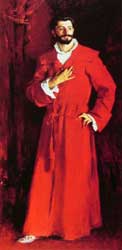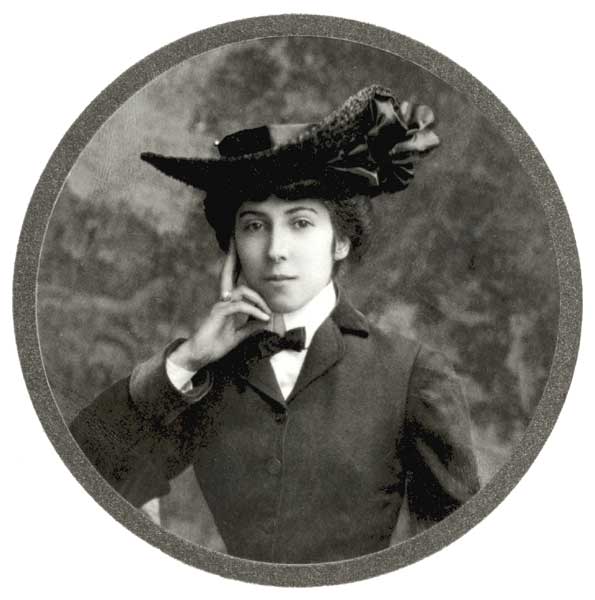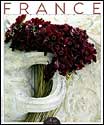|
From:
oldpoetry.com
Catherine
Pozzi was born in Paris,
on July 13, 1883, to Samuel Pozzi and his wife, Therese Loth-Cazalis.
Her
father was a well-known surgeon, and her mother was from Lyon. Their
marriage
was not a happy one. Nevertheless, the Pozzi family, like any other
wealthy
family, kept up appearances. They threw soirees and hosted parties in
their
apartment at Palace Vendome. They visited with the rich, the artists
and
the writers (such as poet Jose-Maria de Heredia and novelist Paul
Bourget).
Samuel Pozzi himself tried his hand at verse, and some of his sonnets
were
published in the Revue de Paris.
Catherine
Pozzi had two younger brothers,
Jacques and Jean. Her education commenced at a girl's school then
continued
at home under various tutors, among them an English governess and a
German
maid. She kept a journal beginning at age eleven, from which we know
that
she read poetry and even wrote some of her own, and played music as
well.
Catherine's social life was active; like many young girls of her class,
she played tennis and rode horseback excellently.
After a fight
with her father, Catherine
went to Oxford. She was interested in philosophy, and also in science.
She only stayed a year, returning home to her mother.
She also
traveled widely: to Italy
with her grandmother and her brother, and to England, where she met
Edouard
Bourdet, her future husband. In 1900, they married, and that year a son
was born. Not long after, Catherine and Edouard Bourdet realized they
were
not meant for each other, and they parted.
Catherine
began to make literary
friends, including Albert Le Chaldier, a professor at the College of
France,
and Marcel Schwob and Andre Fernet, who were writers. She resumed her
studies,
among them, poetry.
She wanted to
be remembered for six
poems, arguing that Sappho had left only particles of poems. Besides
these,
her journals, articles, a philosophical essay, Peau d'ame, and an
autobiographical
story, Agnes.
She argued in
her books "Agnes" and
"Peau d'ame," the philosophy that lessen the hold of substance which
pulled
the individual towards degeneration, both moral and physical, and
fortify
the urge to spirituality, by a lower form in matter, in a greater form
in spirit. As matter and spirit were complementary, by applying virtue
through strength of will, one could overthrow the tendency to
degeneration,
or according to Lawrence Joseph, a sort of "materialistic
spiritualism."
Catherine
Pozzi met Paul Valery in
1924, and he became her lover. One of the six poems Pozzi wished to be
represented by, "Vale," predicted the end of the affair years before it
came.
Catherine was
the victim of Tuberculosis,
and consequently took morphine and opium to reduce her pain. Continuing
her academic efforts, she completed the bacalaureat at Strasbourg and
took
up biology at the Faculte des Sciences in Paris. She wrote articles on
science for 'Le Fiagor', and began to translate poems by Stefan George.
Among her aquaintances was Ranier Maria Rilke, with whom she
corresponded
frequently.
She began to
have "mystical experiences"
which were strengthened by her narcotics, and she was of the belief
that
she communed with her dead friends. She thought her poems were dictated
to her by one who spoke through her pen. Her poems were often very
vague,
and required heavy revision.
In her later
life, she claimed that
suffering was her task--that she was the center of pain on Earth. Her
last
poem--Nyx--was written in November 1934. She passed away in Paris, in
the
December of that year, at age fifty two. Her six poems were published
in
1935.
(oldpoetry.com)
From:
France Magazine
(printed
by
permission)
Sensual
Intellect
Rediscovering
the poetry
of
Catherine Pozzi
by
John Taylor
Catherine Pozzi
(1882-1934) is unjustly
remembered more for her tumultuous liaison with Paul Valéry than
for her exalted story Agnès (1927), her philosophical essay Peau
d’âme (1935) or her love and metaphysical poems, first published
after her death simply as Poèmes (1935). Fortunately, however,
this
mysterious writer has benefited from two energetic advocates in our
day:
critic and publisher Claire Paulhan and biographer Lawrence Joseph, who
recently retired from Smith College. Ever since the late 1980s,
Paulhan,
Joseph and a few other enthusiasts have labored to keep Pozzi’s prose
and
poetry in print and to bring to light unknown writings. Together they
have
deepened critical perspectives on the life and work of a woman who was
befriended and admired by the likes of Rainer Maria Rilke and
André
Gide. Recently Gallimard published Paulhan and Joseph’s richly
annotated
edition of Pozzi’s collected poems: Très haut amour,
poèmes
et autres textes. This slim volume deserves a wide readership.
The poem “Ave”
alone should assure
a lofty place for Pozzi in the history of French poetry. In this poem,
the salient theme of pure love—l’amour absolu—magnificently coalesces
with
metaphysical, cosmological, even mathematical concerns. Addressing her
lover, a woman imagines herself dead, in the future, which is to say
“lost
/ And divided to abysmal infinity, / Infinitely.” Yet her surviving
lover
will still be able to envisage her as a radiant soul, a “living unity
that
is faceless, nameless,” the “center of the mirage.”
Like the
16th-century poets whom
she studied closely, Pozzi sets elevated amorous sentiments against a
philosophical
backdrop. She attempts to heal what her contemporary T. S. Eliot
famously
called the “dissociation of sensibility,” the separation of thinking
and
feeling which, in his view, set in during the 17th century and “from
which
we have never recovered.” Poems such as “Ave,” “Vale,” “Nova” and “Nyx”
likewise aspire to the sensual intellectuality of the great Italian
love
poets, especially Cavalcanti, Dante and Petrarch.
No ave, or
“salutation,” is without
its vale, or “adieu.” The title “Ave” alludes, among other things, to
Catullus’s
elegy “Ave atque vale,” on his brother’s death. With her own “Vale,”
Pozzi
constitutes a similar diptych of affirmation and negation, of amorous
praise
and the acknowledgment of love’s demise. “The great love that you had
given
me,” she laments, “the wind of days has broken its rays.”
Like much of
Pozzi’s verse, “Vale”
involves strange punctuation (or rather, lack of punctuation) and some
tantalizingly obscure passages that nonetheless possess philosophical
resonance.
Exegetes and translators can try their hand on the second strophe, with
its Renaissance cosmography, divided souls, double exiles and mystical
unions: “Notre soleil, dont l’ardeur fut pensée / L’orbe pour
nous
de l’être sans second / Le second ciel d’une âme
divisée
/ Le double exil où le double se fond.” Similar in its use of
cosmic
similes is “Nova,” which in an earlier version was graced with an
epigraph
from Dante’s Purgatory: “The lovely planet, love’s own quickener, / Now
lit to laughter all the eastern sky.” Pozzi often links the soaring
effusions
of love with a heavenly firmament contemplated in all its metaphorical
richness.
In contrast to
this vertical élan,
Pozzi also characteristically moves backward in time. In “Maya,” she
goes
“down steps made of centuries and sand / Leading to you, desperate
moment.”
“I enter your fable,” she adds, “land of golden temples, / Adored
Atlantic.”
Attracted to spiritualism (as were other intellectuals of her time),
she
believed that she had experienced former lives—here as a Mayan,
elsewhere
as an Egyptian, a Greek or an Italian woman.
Inevitably,
however, Pozzi would
come brutally back to earthly realities. She had been diagnosed with
tuberculosis
in 1912, and by her most creative period—the late 1920s—she was
suffering
abjectly from the disease. “Vale,” for example, was composed in a night
train taking her back to Paris from Vence, where she convalesced at her
country home. In her Journal, she recorded the harrowing circumstances
in which the poem was written. “Toward midnight,” she notes, recalling
her chest pains, “I went to the restroom. Sitting on the floor, I gave
myself a shot of Sédol. [...] I hadn’t used such shots for five
months. [...] Peace then came over me. I could think of Lionardo
[Valéry]
without despair. To the rhythm of the train, I sang to myself and
slowly
invented, verse by verse, the [poetic] form [corresponding to] the
suffering.”
At the end of “Vale,” Pozzi once again imagines her dead body; yet she
nonetheless survives in the “form of a heart” through which she will be
able to “relive our great day / And that love that I gave you / For
pain.”
Oddly, only at this ethereal instant does the formal vous of her
initial
words to Valéry become tu.
Pozzi also
devoted a poem to Scopolamine,
another painkiller. She relates how the drug induced sensations of
selflessness
and timelessness: “My heart has left my history,” she senses, “I am
saved
I am lost / I seek myself in the unknown / A name free of memory.”
Pozzi
often imagined death as a stage beyond which her soul not only
persisted
but enabled her to escape, like a Hindu or a Buddhist with respect to
karma,
an endless cycle of reincarnation, memory and suffering.
Pozzi’s Journal
de jeunesse 1893-1906
and her Journal 1913-1934 reveal the personal torment behind this
haunting
vision. She was a gifted woman permanently caught up in a nexus of
conflicts,
frustrations, contradictions and yearnings, not to mention her long
fight
against an incurable illness.
As the daughter
of Samuel Pozzi,
a celebrated surgeon and gynecologist, Pozzi grew up amidst wealth and
culture. Family friends included Sarah Bernhardt, Proust, Colette and
many
other artists. (Her parents formed one of Proust’s models for M. et Mme
Cottard in A la recherche du temps perdu.) Yet her father was
indifferent
to her, her estranged parents lived separate lives and no genuine
efforts
were undertaken, despite the family’s fortune, to give Catherine the
formal
education that her keen intelligence deserved. Defiantly, she became an
impassioned autodidact who could hold her own with the exceedingly
cerebral
Valéry when they discussed higher algebra, contemporary physics
or ancient languages.
She frequented
literary salons,
whose gossip she chronicled acerbically in her Journal. Stimulated by
her
relationship with Valéry, she nonetheless worked slowly and
sporadically
on her writing. Moreover, once Agnès had been brought out to
acclaim
in 1927, Pozzi developed a sort of writerly over-scrupulousness—a
paralyzing
disdainful rigor perhaps mixed with a secret lack of
self-confidence—that
made her look aghast at the prospect of publishing. She even kept
putting
off her friend Jean Paulhan, the resourceful and perceptive
editor-in-chief
of La Nouvelle Revue Française, who often requested prose or
poetry
for upcoming issues. Their lively letters disclose how Paulhan once
coaxed
Pozzi into giving him “Nova” and “Scopolamine,” only to later see the
enfeebled
woman arrive at the print shop, as the December 1932 issue was in the
last
stages of production, and withdraw the poems. Although Pozzi wrote a
few
reviews and scientific articles for Le Figaro, “Ave” (1929) was the
only
poem that she allowed to appear. The critic Ernst Robert Curtius
admonished
her for “wasting such a brilliant, so victoriously obvious, talent.”
Before dying,
Pozzi listed in her
diary the six poems that she most valued: “Vale,” “Ave,” “Maya,”
“Nova,”
“Scopolamine” and “Nyx.” She expressed the wish that they be published
together—a wish that came true when the review Mesures included them in
1935, then issued a special offprint edition. The new Gallimard edition
includes 29 additional poems, her translation of poems by the esoteric
German symbolist poet Stefan George, her French versions of ancient
Greek
Orphic verse, and a few passages from her Journal and Peau d’âme.
“Sappho did not travel through time on more words than that”—as
Catherine
Pozzi herself put it a few days before passing away.
(www.francemagazine.org)
John
Singer Sargent

Dr.
Samuel Jean Pozzi at Home
1881
(Catherine's
father)
Notes:
Special thanks to
Francesca
Miller,
a friend of the JSS
Gallery,-
for sending me a links to these articles.
|







